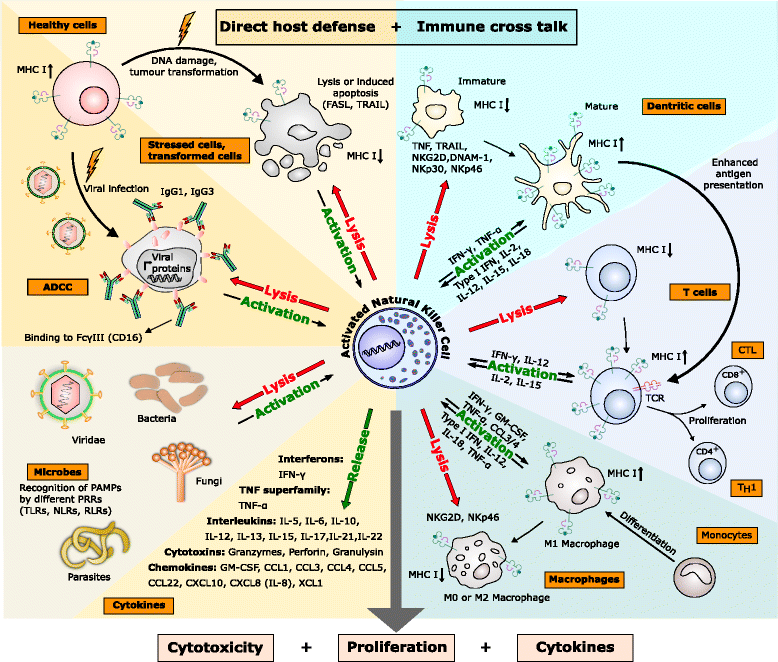Nutritional immunology: function of natural killer cells and their modulation by resveratrol for cancer prevention and treatment
- PMID: 27142426
- PMCID: PMC4855330
- DOI: 10.1186/s12937-016-0167-8
Nutritional immunology: function of natural killer cells and their modulation by resveratrol for cancer prevention and treatment
Abstract
Natural killer (NK) cells as part of the innate immune system represent the first line of defence against (virus-) infected and malignantly transformed cells. The emerging field of nutritional immunology focuses on compounds featuring immune-modulating activities in particular on NK cells, which e.g. can be exploited for cancer prevention and treatment. The plant-based nutrition resveratrol is a ternary hydroxylated stilbene, which is present in many foods and beverages, respectively. In humans it comprises a large variety of distinct biological activities. Interestingly, resveratrol strongly modulates the immune response including the activity of NK cells. This review will give an overview on NK cell functions and summarize the resveratrol-mediated modulation thereof.
Keywords: Immune modulation; Innate immune system; NK cell activity; Nutritional immunology; Resveratrol.
Figures



Similar articles
-
Resveratrol and derivatives for the prevention and treatment of cancer.Drug Discov Today. 2010 Sep;15(17-18):757-65. doi: 10.1016/j.drudis.2010.07.005. Epub 2010 Aug 6. Drug Discov Today. 2010. PMID: 20692359 Review.
-
Concentration-dependent biphasic effects of resveratrol on human natural killer cells in vitro.J Agric Food Chem. 2014 Nov 12;62(45):10928-35. doi: 10.1021/jf502950u. Epub 2014 Oct 31. J Agric Food Chem. 2014. PMID: 25360711
-
Resveratrol diminishes platelet aggregation and increases susceptibility of K562 tumor cells to natural killer cells.Indian J Biochem Biophys. 2013 Feb;50(1):14-8. Indian J Biochem Biophys. 2013. PMID: 23617069
-
The occurrence of resveratrol in foodstuffs and its potential for supporting cancer prevention and treatment. A review.Rocz Panstw Zakl Hig. 2018;69(1):5-14. Rocz Panstw Zakl Hig. 2018. PMID: 29517181 Review.
-
Dietary flavonoids and modulation of natural killer cells: implications in malignant and viral diseases.J Nutr Biochem. 2017 Aug;46:1-12. doi: 10.1016/j.jnutbio.2017.01.006. Epub 2017 Jan 24. J Nutr Biochem. 2017. PMID: 28182964 Review.
Cited by
-
In vivo Anti-Cancer Effects of Resveratrol Mediated by NK Cell Activation.J Innate Immun. 2021;13(2):94-106. doi: 10.1159/000510315. Epub 2020 Sep 16. J Innate Immun. 2021. PMID: 32937636 Free PMC article.
-
Modulatory effect of resveratrol and melatonin on natural killer cell activity and adrenomedullin in diabetic rats.Turk J Med Sci. 2022 Feb;52(1):258-267. doi: 10.3906/sag-2104-380. Epub 2022 Feb 22. Turk J Med Sci. 2022. PMID: 34174798 Free PMC article.
-
Potential Protective Protein Components of Cow's Milk against Certain Tumor Entities.Nutrients. 2021 Jun 8;13(6):1974. doi: 10.3390/nu13061974. Nutrients. 2021. PMID: 34201342 Free PMC article. Review.
-
The anti-Toxoplasma activity of the plant natural phenolic compound piceatannol.Front Vet Sci. 2022 Aug 2;9:972500. doi: 10.3389/fvets.2022.972500. eCollection 2022. Front Vet Sci. 2022. PMID: 35982927 Free PMC article.
-
Epigenetic Regulatory Mechanisms Induced by Resveratrol.Nutrients. 2017 Nov 1;9(11):1201. doi: 10.3390/nu9111201. Nutrients. 2017. PMID: 29104258 Free PMC article. Review.
References
-
- Robertson MJ, Ritz J. Biology and clinical relevance of human natural killer cells. Blood. 1990;76(12):2421–38. - PubMed
Publication types
MeSH terms
Substances
LinkOut - more resources
Full Text Sources
Other Literature Sources
Medical

